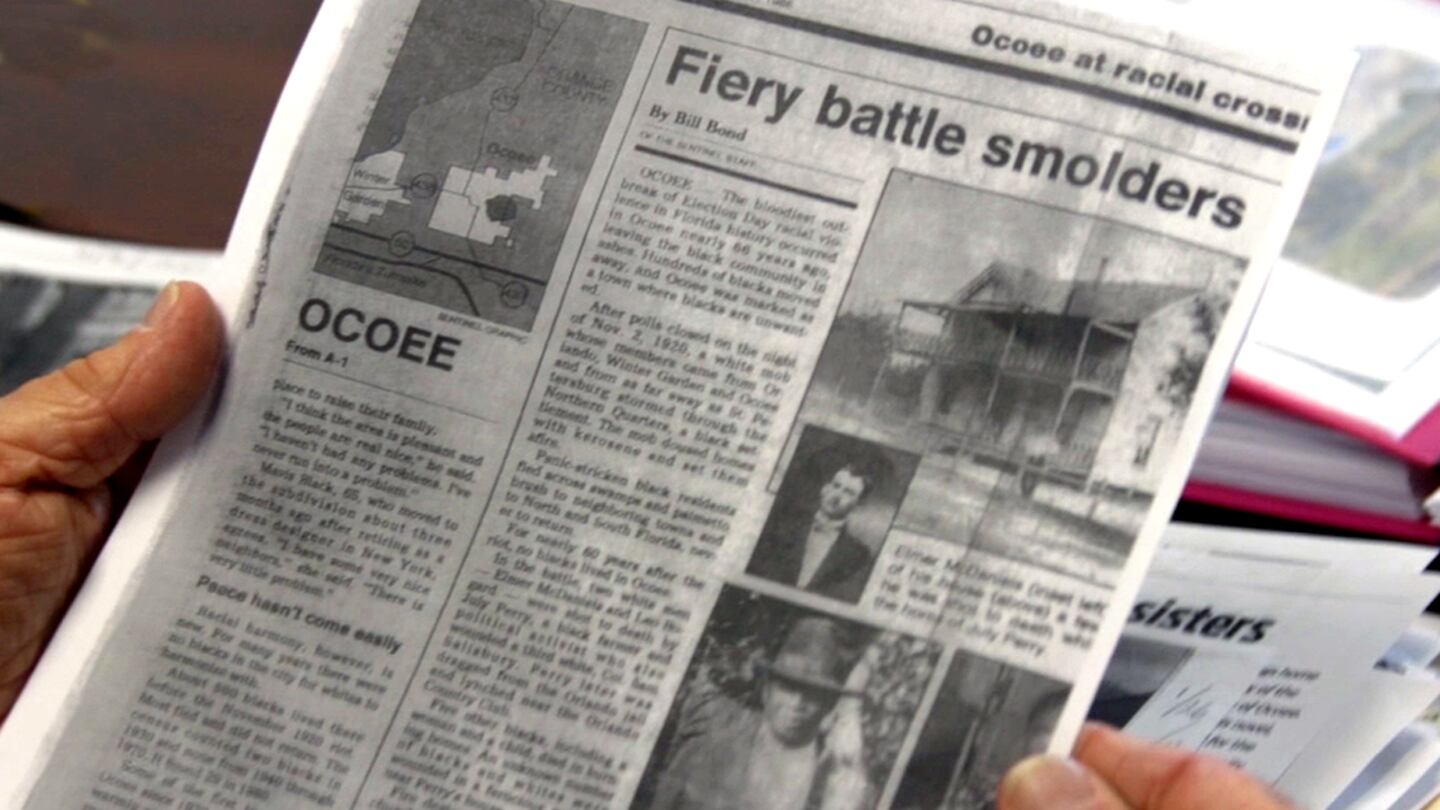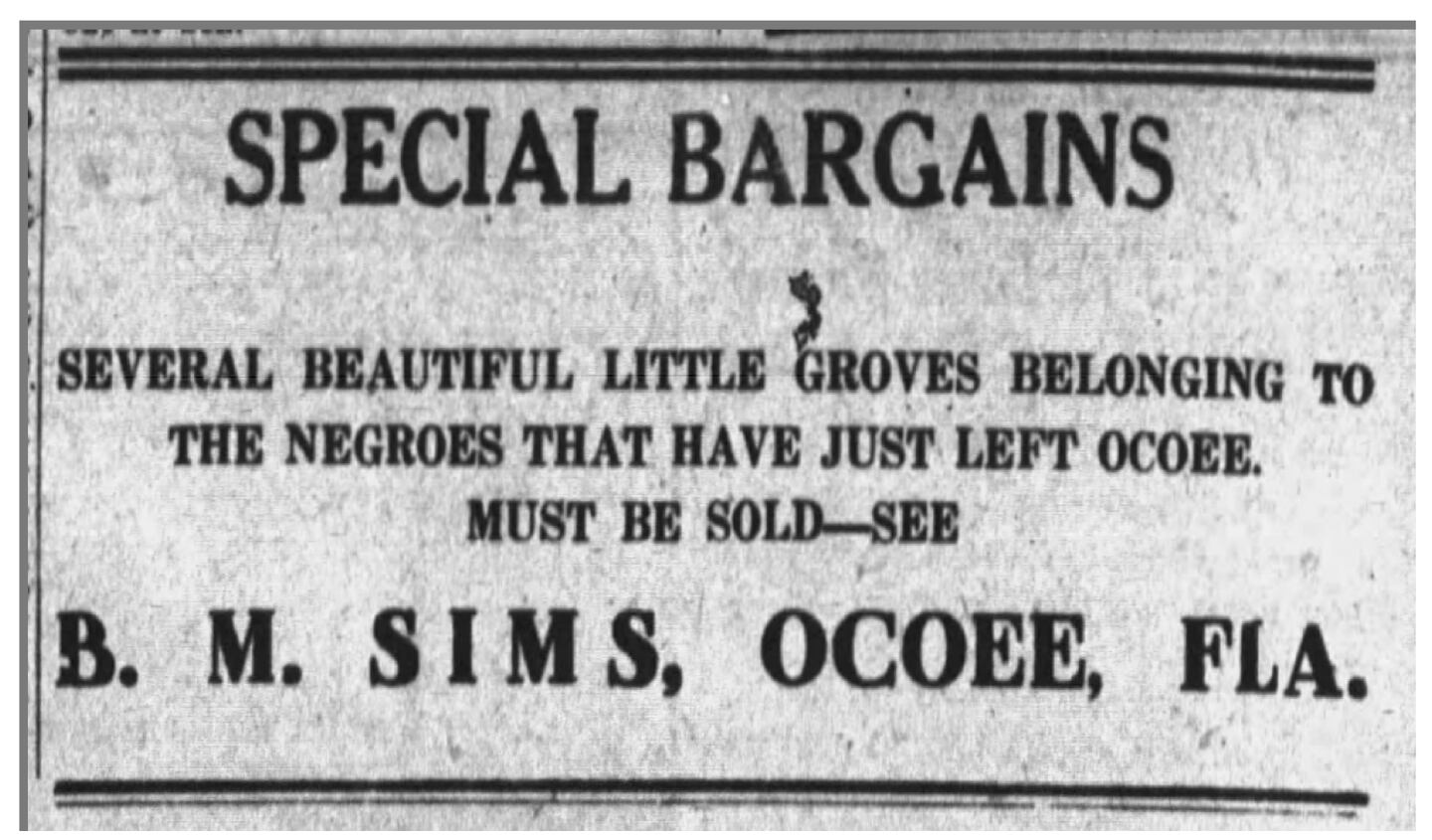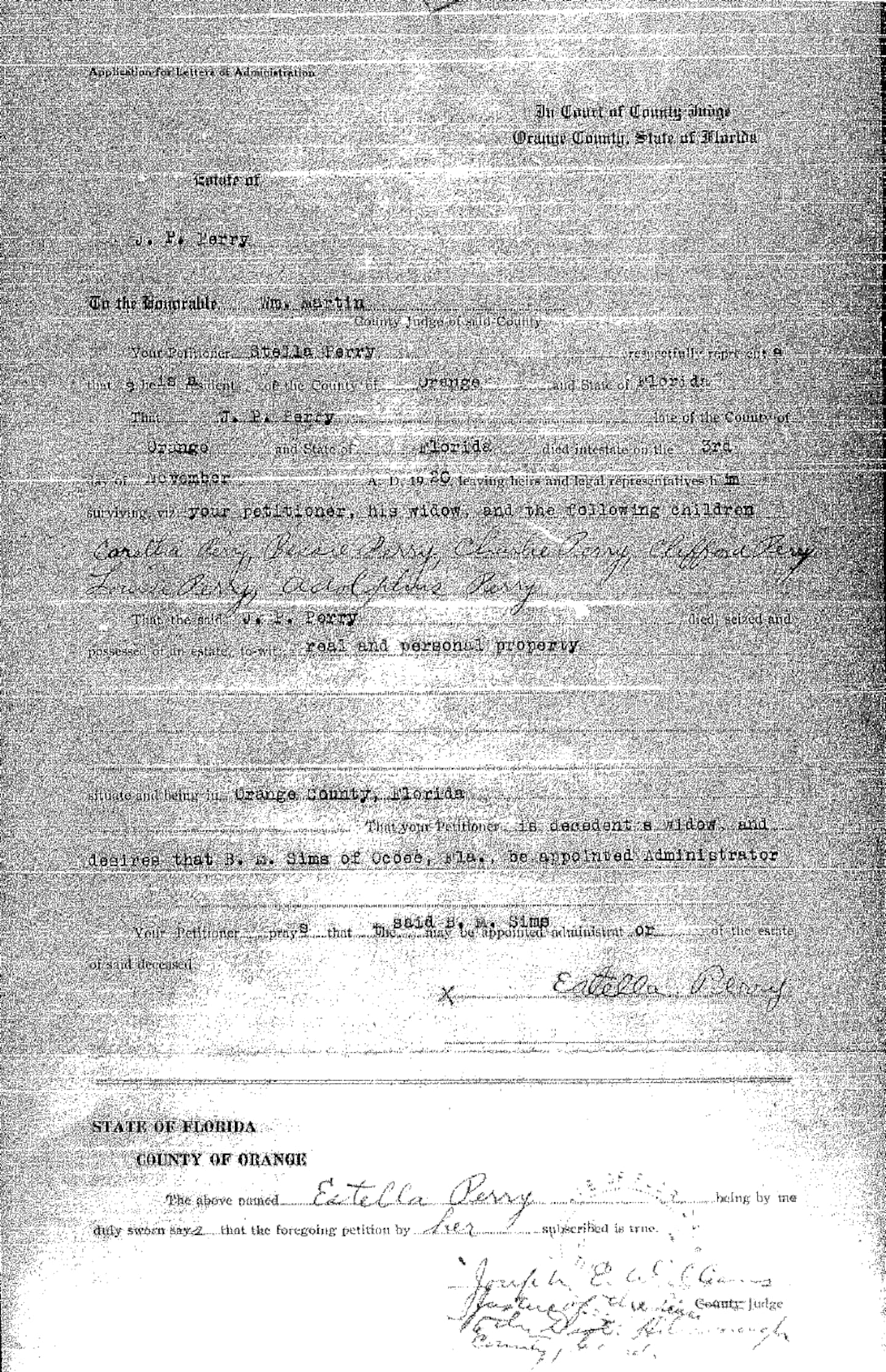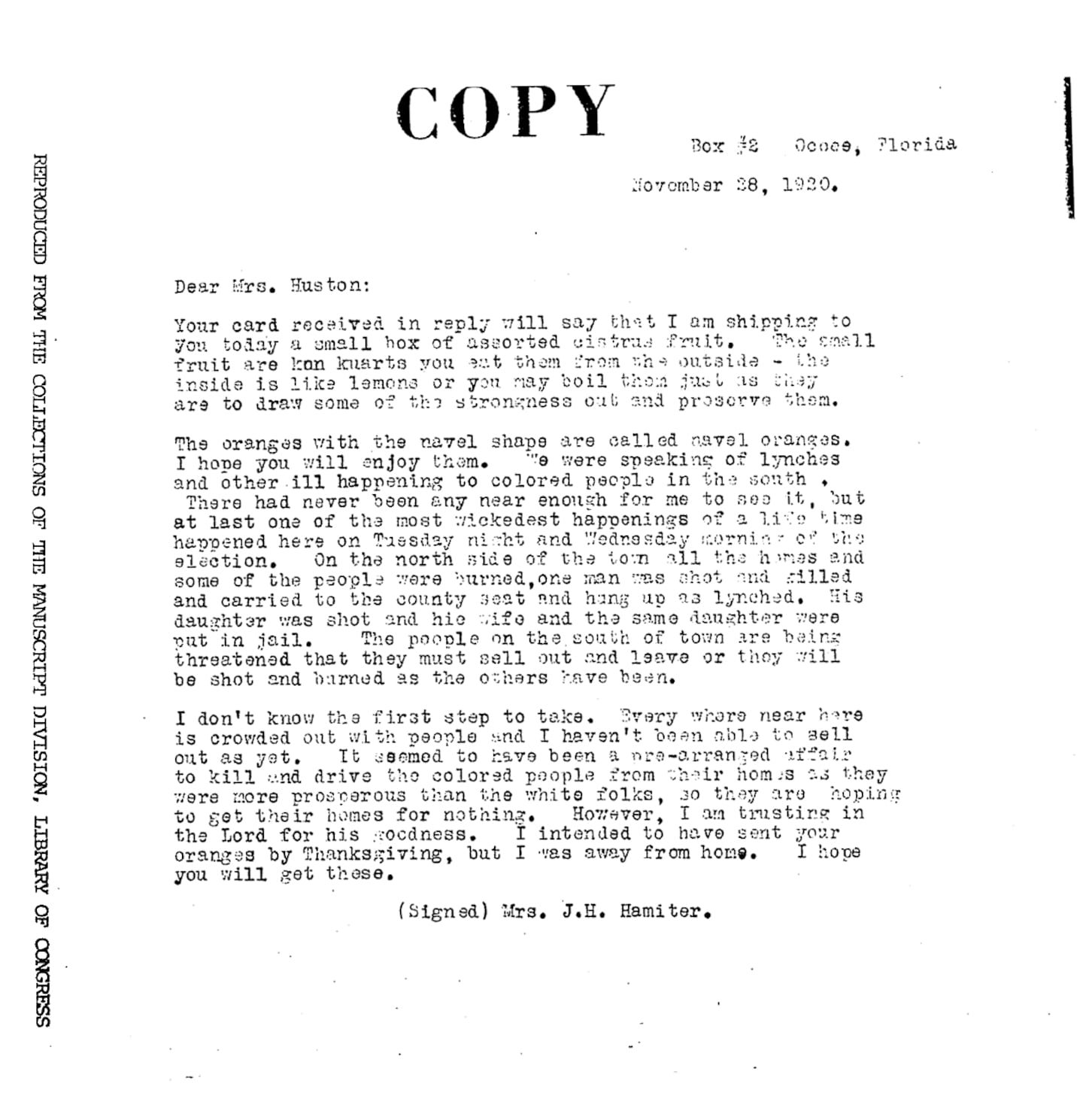The shootout that played out at the home of Julius ‘July’ Perry’s home in Ocoee sounds like something that would be best described as a scene from the wild west. Bullets flying, a wife with her children crawling through the orange groves and swamps trying to escape the gunfire, while Perry stayed back defending his home, family, his pride - and dignity.
He and other Black families were proud of the lives they built by hand. Homes, churches, a community they called their own and often referred to as the Southern Baptist Quarters and Northern Methodist Quarters, the communities sandwiched the area that we know now as downtown Ocoee, or predominately white Ocoee.
Several Black families had earned enough money to buy land, some more than others.
In the days, weeks and months after the shootout at July Perry’s home, the land would be theirs no more. In the span of a decade, 253 Black residents of Ocoee disappeared from the city. They left behind their homes, land, churches- their opportunity.
An entire Black population forced to flee – or face death – and start over – again.
Family members of those who fled and experts on the massacre, including historians, attorneys and community members, have been able to piece together the stories of stolen land and its impact on future generations.
Trapped at the Bottom
According to an analysis by the Economic Policy Institute, people that start life with little or no wealth are often trapped at the bottom of wealth distribution for their entire lives. When you look at that data broken down by race, it shows more than half of white families end up with more wealth than their parents, while only 23 percent of Black families are able to do the same.
So, when hundreds of Black families are forced to start from scratch and leave everything behind, that loss impacts the family’s ability to create generational wealth for decades.
“It’s like if you think of it like a relay race and you have the baton and you run, and then you pass it off to the next person who runs and pass it off to the next person,” Rep. Geraldine Thompson said. “Who do you think is going to get the furthest? The one who has the baton or [the] one who doesn’t have the baton at all? So, if you have no home, if you have no land, it’s like you don’t have the baton.”
A Life Left Behind
Each surviving member of Ocoee’s Black population who owned land had their batons stripped from their hands in the decade following the Ocoee massacre. Some fled that night carrying loved ones on their backs along swampy riverbeds, running from the sound of gunfire echoing through their hometown. Others left gradually.
They left behind their businesses, land and homes.
“We used to own that.”
— Richard Allen Franks
Prior to the massacre, Gladys Franks Bell said her father, Richard Allen Franks, and his family turned Ocoee’s swampy land into profitable farms and orange groves. They bought and sold horses, cows and chickens. “They made money, so life was good,” Bell said.
Then, after the violence broke out when her father was 18, he and his family fled to the small town of Plymouth just north of Lake Apopka to start from scratch.
Bell said her father and grandfather would work in orange groves during the day and “grub” at night, clearing land. They saved up enough money to build a well, then a house, then more land to build more houses to rent out to others. But Bell said when her family would drive through Ocoee and look back at what they’d left behind, tears would sometimes well in her father’s eyes.
“My dad would show us, he’d say, ‘See all of that? We used to own that,’” she said.
But after a while, they stopped driving through. It was too painful to look at what had once been theirs. “We just stopped looking and it was kind of heartbreaking. And every time my dad would be talking about that, sometimes we’d see a little tear come from his eyes over all that they lost,” she said.
Bell said no one in her family was compensated for the land that they left behind. “The only reason we know that it ends up in white hands is because there were no Black hands left in Ocoee for it to be in. I think that’s the only thing that we know for sure,” said Melissa Fussell who published a law review about the Ocoee Massacre and studied deed records available. “And we know for sure that the people who originally owned the land did not have any fair options.”
Hidden in the Swamp
Robert Hickey grew up in his grandparents home in Apopka. Years earlier, John and Lucy Hickey were among the Black families that escaped the violence in Ocoee on Nov. 2, 1920 and the days that followed. “At an early age, I didn’t have any idea what that was all about,” Hickey said. “They just used to always mention Ocoee, Ocoee.”
John Hickey settled in Ocoee from Moultrie, Georgia. His wife, Lucy, was from the panhandle. “We used to go up and visit her mom on the Greyhound," he recalled.
He distilled turpentine; they had a lot of property. “He had an automobile, which was kind of rare.” Hickey said.
“They stood on the front porch and just started watching all these friends' properties going up in flames, and it kept getting closer to them." Hickey said his grandmother told him years later, describing the terror that they escaped their home in Ocoee, hiding in stump holes in the swamps around Lake Apopka.
They left behind what he would later discover was at least 50 acres of land. “I have all the contracts,” Hickey said. The family tried to hire a lawyer who worked on a reparations measure for the victims of the Rosewood massacre, but they were told the state of Florida would never allow another bill like it to pass the legislature.
$9 Million Value
In an exhibit focused on the Ocoee Massacre, the Orange County Regional History Center estimates the land the Black residents left behind or was stolen from them following the massacre would be valued at more than $9 million today.
Bell said when she drives through Ocoee now, she still sees the injustice that happened a century ago.
“I see the hard-earned work of the Blacks in my family that bought this and was not compensated for it and to see all of these buildings, stores and everything that’s on it, that kind of saddens me,” she said.
July Perry didn’t live to see what happened to his land. After the shootout at his home, he was dragged and lynched near what is now the Country Club of Orlando.
“That land has blood on it.”
— Stephen Nunn
When Perry was killed, his property should’ve been turned over to his wife, Estelle. Perry’s great-grandson, Stephen Nunn, said his grandmother’s name was forged on documents, allowing local officials to sell off Perry’s land following his death.
“It was actually stolen,” Nunn said. “It’s still stolen land to this day. It’s still land that belongs to not only July Perry, but other descendants of Ocoee. That land has blood on it.”
Perry’s wife and daughter were arrested following the massacre and later taken to a Tampa jail before being exonerated. Public records WFTV reviewed for our documentary about the Ocoee Massacre show a court order approved by Judge Frank Smith, appointed Captain Bluford Marion Sims as administrator of the estate instead of his wife. Mrs. Perry’s signature appeared on the application for administration of the family property. The Order Appointing Administrator was dated Nov. 13, 1920. Mrs. Perry and her daughter remained in jail until on or around Nov. 30.
More court records we reviewed show that the Perry family filed a petition with the court to recover his estate, but when Sims' daughter, Eva, took over as court appointed guardian of Perry’s estate, when Sims' himself was declared insane, Eva refused an order to provide an account for the property. Later, a deed for the property was amended and prohibited the land from being sold or conveyed to a black person.
“So really you have government involvement from the beginning to the end and where they’re outsiders involves probably were. But I think that the evidence we have is that it was the government that was primarily involved,” Fussell said.
Jackson and Annie Hamiter were among the first blacks to settle in Ocoee in the late 19th century. In the days following the massacre that started on election day, J.H. Hamiter, likely Annie, included a letter in an orange shipment, in which she described the violence and the push to force blacks from their homes.
She wrote in part:
“At last one of the most wickedest happening of a life time happened here on Tuesday night and Wednesday morning of the election,” she wrote. “On the north side of the town all the homes and some of the people were burned, one man was shot and killed and carried to the county seat and hung up as lynched. His daughter was shot and his wife and the same daughter were put in jail. The people on the south of town are being threated that they must sell out and leave of they will be shot and burned as the others have been,” Hamiter wrote. “It seemed to be a pre-arranged affair to kill and drive the colored people from their homes as they were more prosperous than the white folks, so they are hoping to get their homes for nothing. However, I am trusting in the Lord for goodness.”
Knowing the history of Ocoee, including the destruction of the land and property in the black community, Nunn said he feels unsettled every time he returns.
“When I go to Ocoee, even now, something just doesn’t feel right,” he said. “I see new buildings. I see modern decorations. I see progression. And yet at the same time, I feel in my spirit.. regression, you know, stagnant the same, and maybe some of that is transcended down through generations.”
He said the fact that the land his great-grandfather owned still exists with his family never having received a penny of compensation feels like “the highest level of injustice.”
The story is different for the victims and descendants of the Rosewood, Florida, race-based massacre in 1923. A mob of about 1,000 whites obliterated the Black community there.
An attorney, Stephen Hanlon, took on the Rosewood case and through testimony, but mostly his law firm’s power of influence, convinced the state legislature to approve a form of reparations for the victims and the descendants, which turned out to be no more than $150,000 for living survivors and no more than $2,000 for descendants. The measure also covers four years of college tuition at a state school.
Financial Repair Proposals
For Ocoee descendants – there is nothing.
State Senator Randolph Bracy tried, but the conservative legislative bodies refused to include any such language in an Ocoee Massacre education bill he proposed and was later approved in Spring 2020 and signed by Governor Ron DeSantis in June. “I had a conversation with a leader in the Senate who told me that they supported the education portion of this bill, but they would in no uncertain terms financially repair the victims of the Ocoee Massacre. That part was dead on arrival,” Sen. Bracy said.
He had to decide on whether he would drop the bill, knowing the financial piece was most important to the descendants, or move forward. “I think it’s interesting that I was able to push basically an African American education bill forward in the Senate, but in the House, it did not have any movement at all. But a Holocaust education bill sailed through the House and the Senate. And I think that it just speaks to the priority of the legislature, of us as Americans and how we view African American history, compared to other histories,” said Sen. Bracy, who plans to push the measure again in the 2021 legislative session.
“People left and didn’t want to talk about it.”
— Pamela Schwartz
Pamela Schwartz, a curator with the Orange County Regional History Center, said record searches tell her that there were 21 individual Black landowners who owned 36 properties accounting for over 300 acres of land in Ocoee before the massacre. Schwartz said a decade later, the only Black residents of Ocoee were two servants listed as living in their white employers' homes. It would be another four decades until another Black family attempted to move in.
The Black families who lived in Ocoee at the time of the massacre and survived, in many cases, left with no intention to ever return, Schwartz said.
“The families really spread out, and I think that’s also a part of which what makes this story so hard to know is because people left and didn’t want to talk about it,” Schwartz said. “They wanted to start new. They wanted to get away from it.”
Cox Media Group












